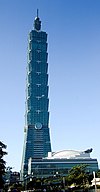Economic history of Taiwan


This article needs additional citations for verification. (September 2022) |
| History of Taiwan | ||||||||||||||||
|---|---|---|---|---|---|---|---|---|---|---|---|---|---|---|---|---|
 | ||||||||||||||||
| Chronological | ||||||||||||||||
|
||||||||||||||||
| Topical | ||||||||||||||||
| Local | ||||||||||||||||
| Lists | ||||||||||||||||
|
| ||||||||||||||||
The
In the 1950s, the ROC government, retreated to Taiwan after losing the
Prehistory
According to archaeological evidences,
Analysis of
In the early Neolithic period, jade was used only for tools such are adzes, axes and spear points. From about 2500 BC, jade ornaments began to be produced, peaking in sophistication between 1500 BC and 1 AD, particularly in the Beinan Culture of southern Taiwan. All the jade found on Taiwan came from a deposit of green nephrite at Fengtian, near modern Hualien City. Nephrite from Taiwan began to appear in the northern Philippines between 1850 and 1350 BC, spawning the Philippine jade culture. Around the beginning of the Common Era, artisans in Taiwan switched from jade to metal, glass and carnelian. However, Philippine craftsmen continued to work jade from Taiwan until around 1000 AD, producing lingling-o pendants and other ornaments, which have been found throughout southeast Asia.[4][5]
Artifacts of iron and other metals appeared on Taiwan around the beginning of the Common Era. At first these were trade goods, but by around 400 AD wrought iron was being produced locally using bloomeries, a technology possibly introduced from the Philippines. Distinct Iron Age cultures have been identified in different parts of the island: the
Contacts with Europe
The Dutch recognized the significance of cane sugar as an export product and extensively developed the industry in the areas under their control. Dutch exports of sugar rose rapidly throughout their colonial tenure and had reached 1,300 tons by 1660, a tenfold increase from 1636.[8]
The main purpose of the occupation of Taiwan was to trade with
At the time, the Japanese were also interested in commercial activities in Taiwan. As a result of the economic challenge from the Japanese, the Dutch East India Company levied heavy taxes on the Japanese merchants. In 1628, the Japanese kidnapped
Early Chinese administration
Amid the
After defeating Koxinga's private army, the
In 1858, four ports were opened in
Japanese administration

For the most part, Taiwan's economy during the Japanese rule period was a colonial economy. For example, the human and
Under Governor Akashi Motojiro, a vast swamp in central Taiwan was transformed into a huge dam in order to build a hydraulic power plant for industrialization. The dam and its surrounding area, known today as Sun Moon Lake, has become a must-see for foreign tourists visiting Taiwan.
Although the main focus of each of these periods differed, the primary goal throughout the entire time was increasing Taiwan's
Modern history
After the Kuomintang retreat to Taiwan, the Taiwanese society was relatively stable politically in the 1950s. However, it faced some obstacles economically as a result of the mass destruction during World War II and the Chinese hyperinflation in the 1940s. The sudden increase in population caused by the Kuomintang migration from mainland China also affected Taiwan's economy.
Facing the economic pressure, the Kuomintang regime established several economic plans and policies. Of primary importance for the long-run growth of this economy was the commitment to education, beginning with universal elementary education, expanded to upper level schooling as basic levels of literacy were attained. The New Taiwan dollars were issued to replace the Old Taiwan dollars. Successful land reform also took place, enabled by the KMT's interesting role as recent immigrants, and not vested landowners. In addition, the United States aid also helped the reformation of Taiwan's economy.
The government also carried out an
A major turning point in Taiwan's economy was during the 1970s. The expulsion of the

No Inverted yield curves
After the 1980s, Taiwan's economy began to stabilize. It eventually became one of the Four Asian Tigers as a dynamic capitalist economy. The 1997 Asian financial crisis did not affect Taiwan nearly as harshly due to greater restrictions on the outflow of invested foreign capital than were in place in countries hurt by rapid capital flight. The Chen Shui-bian administration in the 2000s focused on joining international organizations. Taiwan was able to join the World Trade Organization in 2002.
See also
References
- ^ "Land-to-the-tiller program transformed Taiwan".
- ^ Land Reform Museum(土地改革紀念館). "Looking for History (尋訪歷史)" (in Chinese). Archived from the original on 2011-07-25. Retrieved 2008-03-30.
- ISBN 978-957-801-660-6. 根據張光直(1969)...9,000BC起...大量種植稻米的遺跡 [Chang, Kwang-chih(1969): ...traces of slash-and-burn agriculture since 9,000 BC... remains of rice cultivation]
- PMID 18048347.
- ISBN 9789719429203.
- .
- ^ Chen, Kwangtzuu (2009). "Iron Artifact". Encyclopedia of Taiwan.
- ^ Crook, Steven. "Touring the Remains of Taiwan's Sugar Industry". topics.amcham.com.tw. Taiwan Topics. Retrieved 14 July 2020.
- ^ a b Huang, Fu-san (2005). "Chapter 6: Colonization and Modernization Under Japanese Rule (1895-1945)". A Brief History of Taiwan. ROC Government Information Office. Archived from the original on 2007-05-22. Retrieved 2006-07-18.

